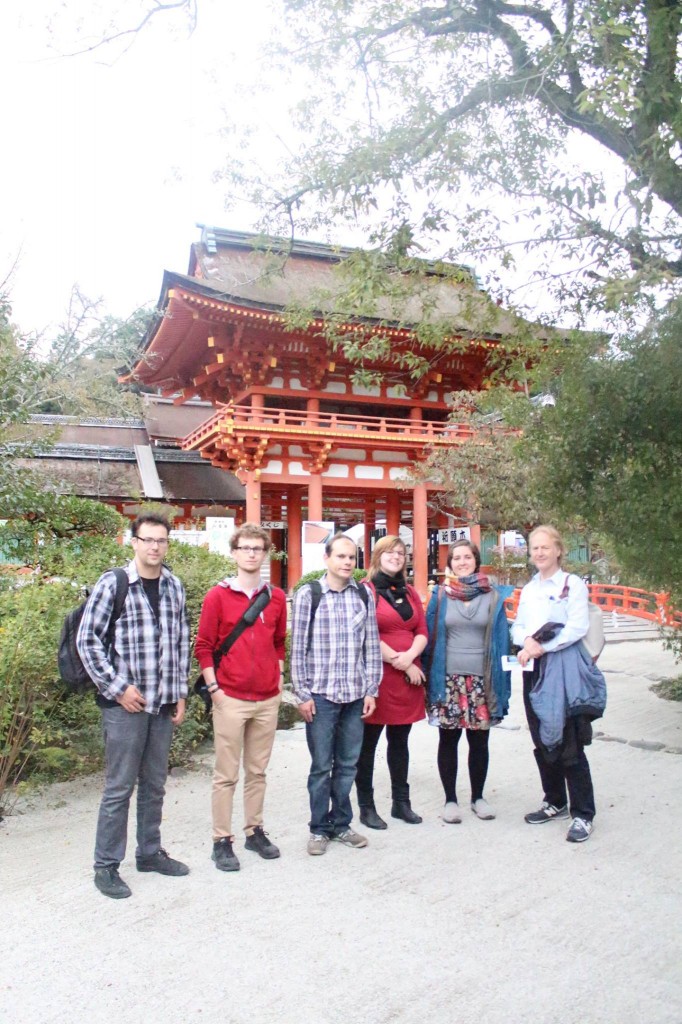
The group pose before the gate into the inner compound of the shrine (courtesy Inui sensei)
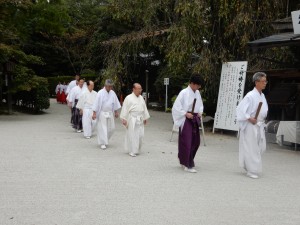
Shrine staff filing out for morning prayers
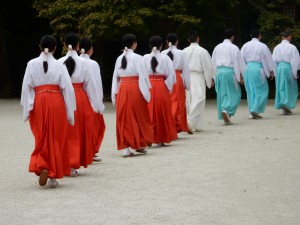
.. and filing back again afterwards
Kamigamo Jinja offers shrine tours by an English-speaking priest, and this week a group of young Germans were able to make a special visit to this World Heritage site. It was a rare chance to hear directly from a Shinto priest familiar with Western thinking. It enabled participants to enter into parts of the shrine normally off-limits, as well as to see firsthand the work involved in the 21-year cycle of rebuilding. By good fortune, the beginning of the tour coincided with the procession of shrine staff to their morning prayers, and the end of the tour with a purification ceremony prior to a ritual celebrating the empress’s birthday. It was quite an experience.
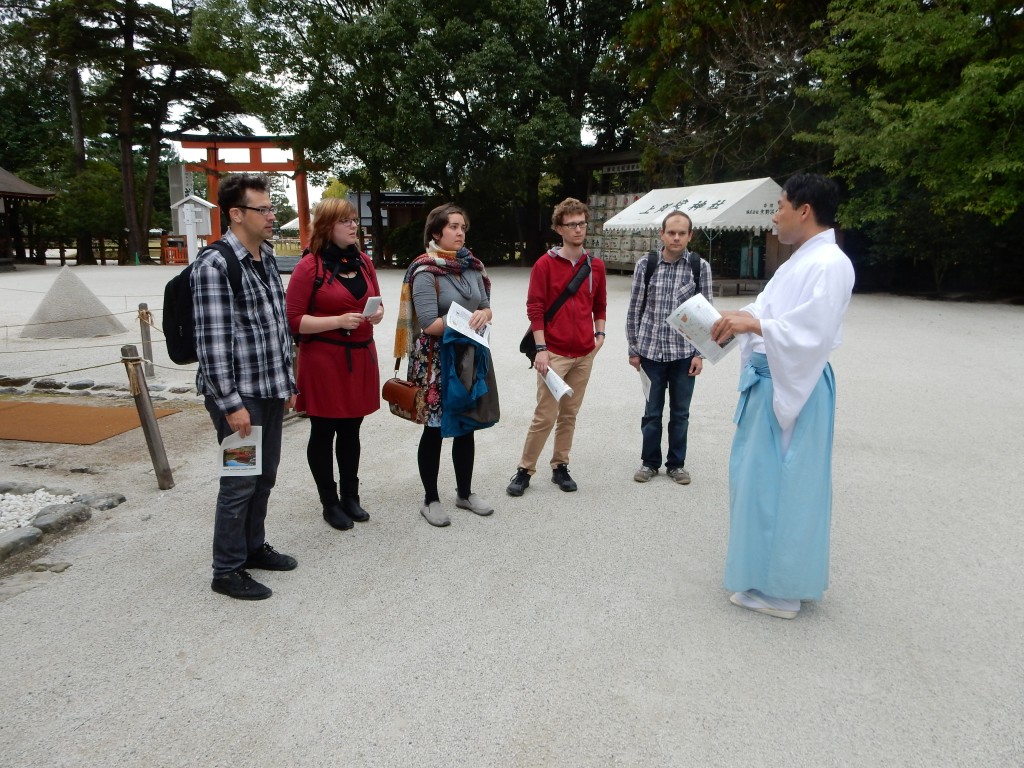
Inui Mitsutaka explains about Shinto to the group of Germans. In the background is one of the two conical piles of sand representing the shrine's sacred hill
After an initial introduction to the history of the shrine (‘Kyoto’s oldest’), Inui sensei led the group to the water basin, where they were instructed in the proper etiquette – left hand, right hand, left again and wash out your mouth. One interesting observation was that afterwards the ladle should be held up so that the water runs down the handle in order to clean it for the next person – in this way the Japanese custom of consideration for others is expressed.
As we approached the shrine proper, it was pointed out that there were three bridges in all that worshippers would pass over – a kind of purification in itself. The streams passing through the shrine grounds are an example of early Shinto’s reverence for nature, and one building set over a stream, considered the most pure in the shrine, is reserved exclusively for the envoy of the emperor.
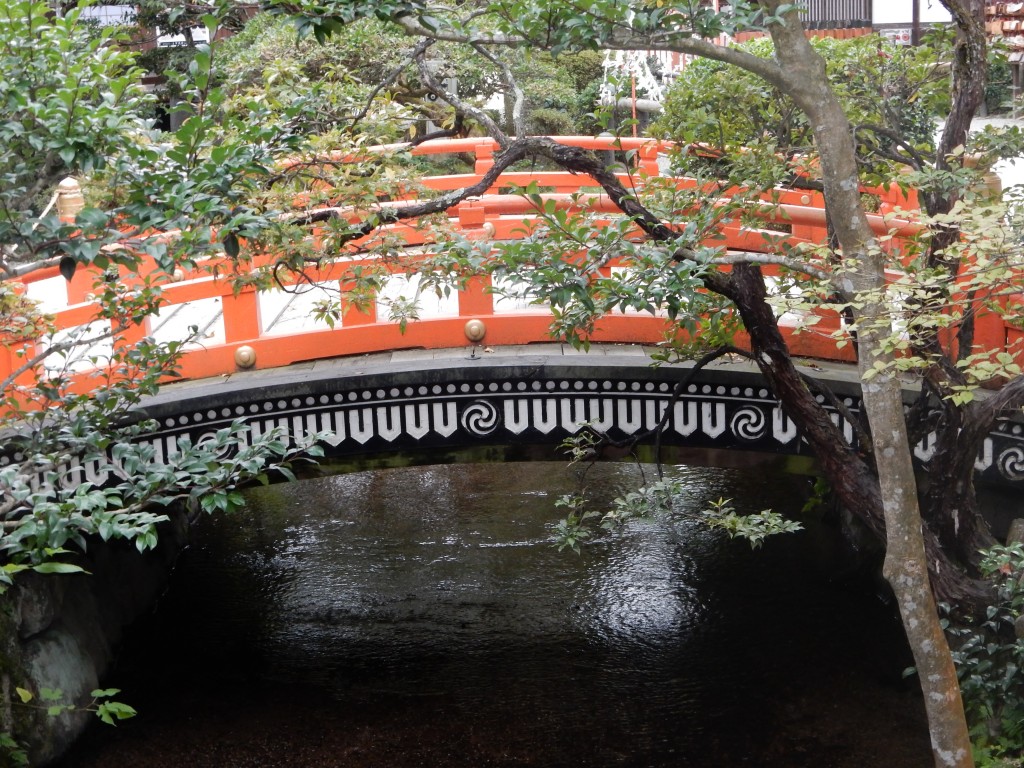
The shrine is full of symbolic crossings, the passage over water conveying the visitor to a purer world.
The shrine was built by the Kamo clan, who settled the area some 1500 years ago, and dedicated to a thunder deity called Kamo Wake Ikazuchi no mikoto. In the inner courtyard a room with paintings by a twentieth-century artist tells the story of the his virgin birth. His mother, a shamanness called Tamayori no hime, was purifying herself in the river one day when a red arrow came floating by. She took it home and placed it in her room while she slept. Next day she found herself pregnant.
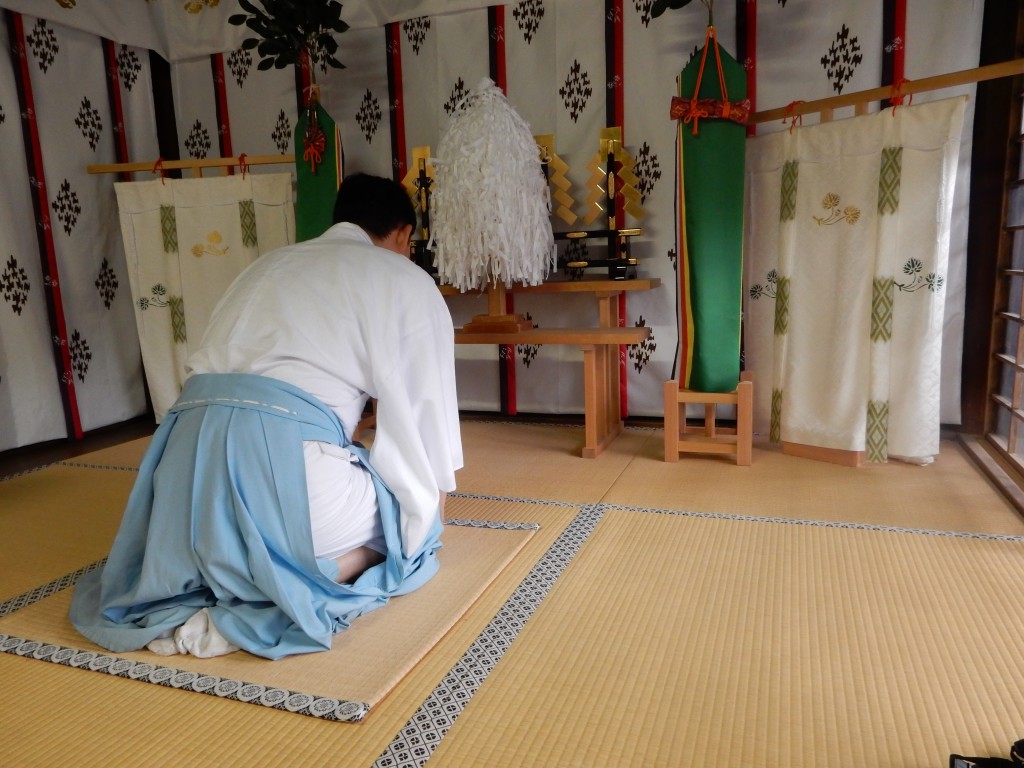
Inui sensei prepares to perform the purification ritual
When the young boy came of age, he was asked at a ritual of celebration to place a cup of saké in front of his father. Declaring his father to be up in heaven, he ascended into the skies accompanied by thunder and lightning. Later he appeared in a dream to his mother and told her that he would revisit if a suitable ritual was put on for him with aoi leaves (thought in the past to be a protection against misfortune). This was the beginning of the famous Aoi Festival held every May, the oldest of Kyoto’s Big Three Festivals.
Prior to visiting the main sanctuary where the kami resides, Inui sensei conducted a purification ceremony and instructed the Germans in the correct way to pay their respects (2 bows, 2 claps, 1 bow). The clapping he pointed out was a way of connecting with the kami, with the left hand representing heaven and the right hand earth. Mindful of the fact that the young Germans were attached to a Christian organisation (the NCC in Kyoto), Inui sensei was careful to stress that activities such as washing hands and paying respect were cultural rather than religious activities.
Our ‘prayers’ took place not in front of the Honden, which was under repair, but the adjacent Gongen – ‘a permanent temporary sanctuary’. This is unique to Kamigamo Jinja, and indicative of the high status the shrine enjoyed in times past when it was ranked no. 2 after Ise in importance. Unusually the komainu guardians are not statues, but painted on the wall. However, at the Shingu Shrine adjacent to the Honden are strikingly colourful statues of komainu, made of wood covered with lacquer and then silver-leaf in one case and gold-leaf in the other.
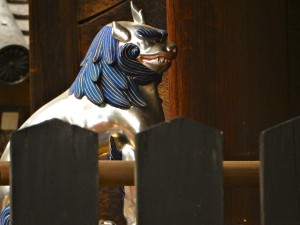
A silver-leafed komainu...
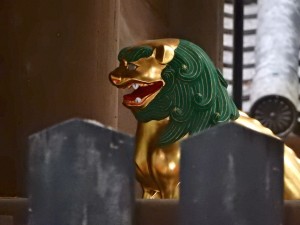
... facing a gold-leaf covered komainu
Every 21 years the shrine is renewed in a shikinen sengu cycle (only about a dozen shrines still keep this expensive custom, including most famously Ise Jingu). The roof alone involves an extraordinary amount of time and labour. First strips of cypress are torn from a tree, which must be over 80 years old. The bark will grow back after ten years, and the reason for the use of cypress is because it is resistant to bugs. After the renewal, the old bark strips are returned to the soil to be recycled by nature.
The strips are carefully laid one on top of each other, and considerable skill is required in the rounding of the roof shape to ensure rain runs off it. Progress is slow – less than a meter a day – and bamboo nails are used to fix things in place (only two people are left in the whole of Japan, a father and son, who are able to produce these nails!). For the roof above the kami, ceramic tiles are never used because they are made from soil on which humans have trodden. It’s symptomatic of the high esteem in which the kami is held.
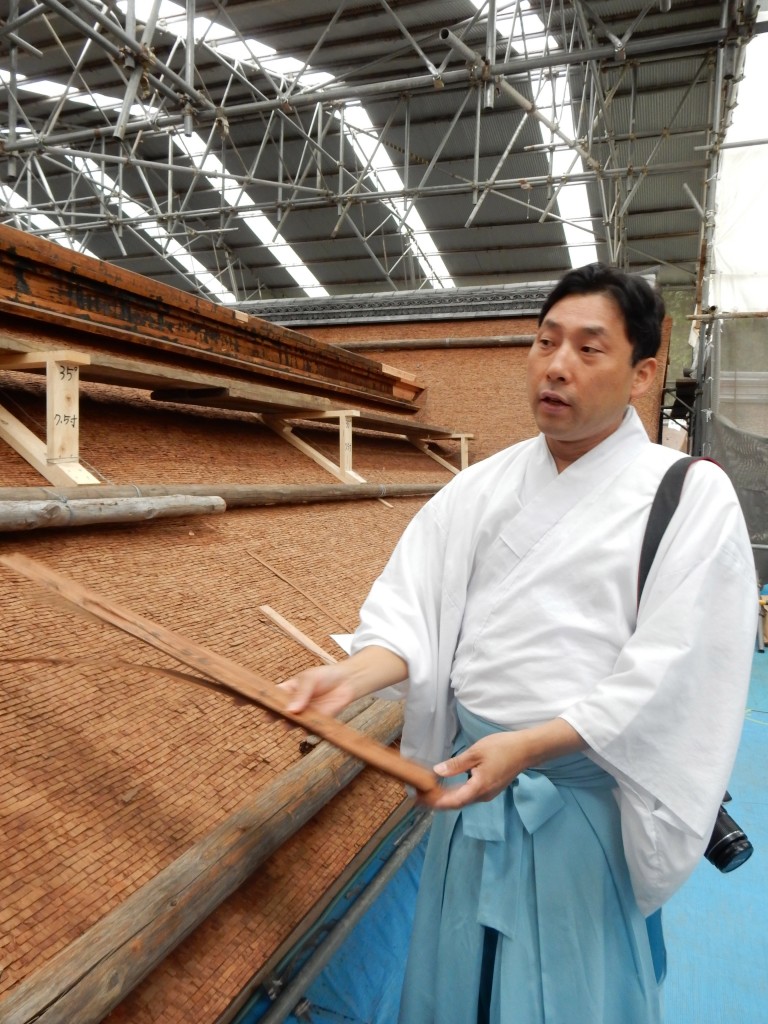
Inui sensei explains about the cypress strips that are used in the roofing
Our visit happened to coincide with the empress’s birthday, and Inui sensei explained that the ceremony held to honour this was also for the well-being of the country as a whole since it was written in the constitution that the imperial family was the symbol of the nation. Before dispersing, we were able to watch the priests’ purification prior to the ceremony, at which they pass a small stick over their body to absorb impurities which is then placed into the stream to be washed away.
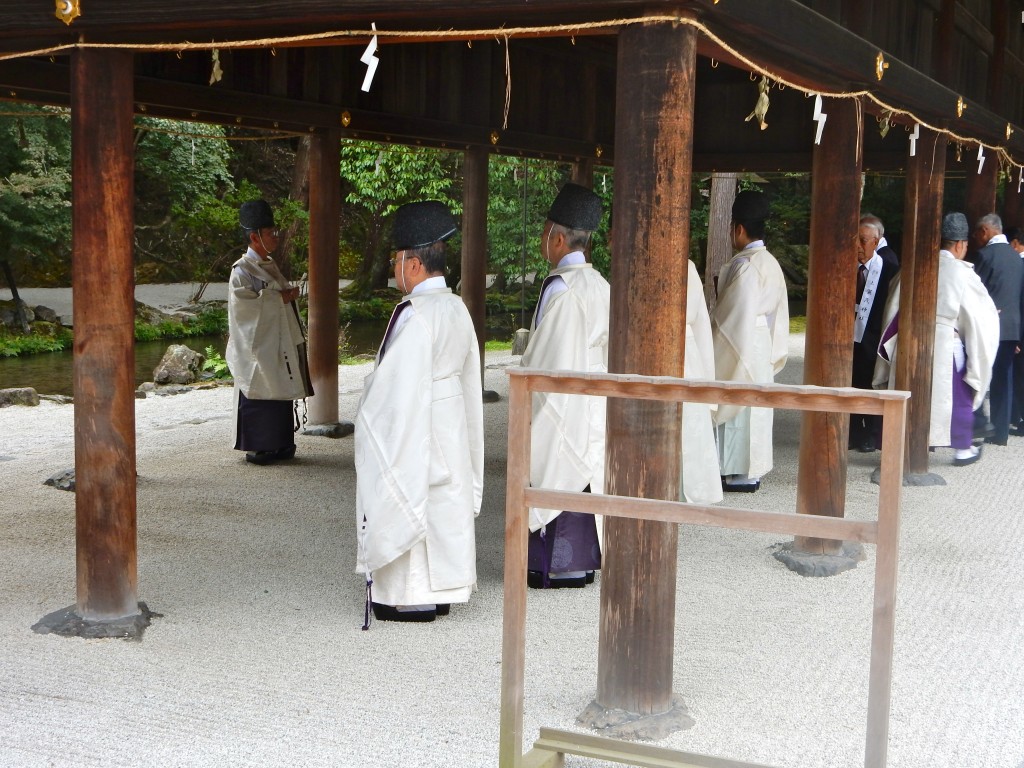
Priests line up in front of the stream for ritual purification. A small stick is waved over the body to absorb impurities, then thrown into the stream in the background to be washed away eventually to the sea.
**************************************
For tours of the shrine, notice is required in advance. Tel 075-781-0011 Fax 075-702-6618 (Tour time of 20 to 30 min. Donation 500 yen, per person (Group: 20 and more 450 yen per person)
For a detailed guide to Kamigamo Jinja, see Shinto Shrines by Cali and Dougill, p.115-118

That was a nice coincidence, the birthday of the empress and the rituals associated with it. Enjoyed your post!
Good evening
It’s first time to visit your blog .very nice for study!
Do you mind if I comment by Japanese next time?
No, please feel free to write in Japanese and I’d be very interested to hear your opinions…
Good morning
Thanks for your friendly answer
I can read English but not good to conversation
ゆっくり貴サイトを拝見してから、また話しかけますので
よろしくお願いします^^